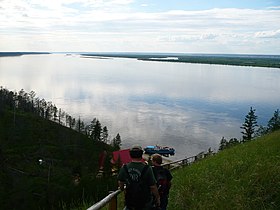
At the top of the west and northwest of Lake Baikal, the river flows mainly northward. 4400:. A small lake Baikal in the range, in the Baikal-Lena Reserve, 10 km west of Lake Baikal, 1800. The Lena flows north to 19 km, 600 meters to lose altitude and becomes possible in the rafts. Branches to the west and then south to lose another 600 meters to 128 km for Chanchur, where a ranger station. 4222: Kachuga: Beginning of navigation, route of Irkutsk. 4197: Verkholensk: Kulenga mouth of the river north-west through the mountains, the river tutur. 4108: Zhigalovo: start of passenger service, including hydrofoil to Ust-Kut. Canyon downstream.
In the middle section of the river flows mainly north-east. 3705: Ust-Kut, northwest of the northern tip of Lake Baikal. In times of the Cossacks, was the site of a portage between the Yenisei and Lena. Today is the point where the railway crosses the Baikal-Amur mainline Lena on a bridge and manages 80% of the load in the region of the Sakha Republic. 3698: Lena: It's really a part of Ust-Kut, which is widely dispersed. Lena is the river port. 3397: Kirensk: harbor and old Cossack. 3101: "The path of the devil," a section of flood danger. 3096: Shcheki ("cheeks"), a narrow section, with cliffs and turns. Republic of Sakha border. 2955: Vitim: Vitim River and south. We are now north of Lake Baikal. River widens. Many dead trees in the water. 2931: Peledui: Peledui River, ship repair company and the salt mines. 2744: Lensk: the most important port between Kirensk and Yakutsk. Route 230 km north of the mine Mir.
There was a breakpoint in the "Perlinsky Trakht" an old mail route. Lena turns southeast and northeast. 2587: Chepaevo: 2547: Masha, 2337: Olyokminsk:, Olyokma River to the south. The river is 2 km and floodplains. 2213: Uritskoe, 2030-1850: Lena key areas: the rocks along the right bank. 1937: Sinsk, Sinsk River and petroglyphs. 1820: Mokhsogollokh: ferry and opened the way to Yakutsk on the front (west) bank. River to the north. 1805: Pokrovsk: Downstream Cliffs smoking, narrows, CPL and planned instead to fill the Yakutsk Mainline rail Love. Nizhny Bestyakh: 13 km south of Yakutsk on the left side of the road between the southern Lena. In the Kolyma highway to the Pacific Ocean begins in the neighborhood.
At the bottom of the river flows mainly northward. 1710: Yakutsk:. 1560 Aldan River in the east. Rio tends toward the northwest. 1373: Sangar: the coal mines. 1560: Vilyuy River from the west. River going north. 959: the Arctic Circle. 939: Zhigansk, founded in 1632, 865: Agrafena island. 545: Sikhtyakh. 385: Kyushur: regional center. 222: Lena Delta. 0: Tiksi: east of the continent in the delta. Port, airport, two and a half months sailing season. Five degrees north of the Arctic Circle.
 At the end of the Lena River Delta is a great stretching 100 km in the Laptev Sea and is located about 400 km (250 miles) wide. The delta is frozen tundra for about 7 months of the year, but in May transforms the region into a lush wetland area in the coming months. Part of the area is protected as a Wildlife Reserve in the Lena Delta.
At the end of the Lena River Delta is a great stretching 100 km in the Laptev Sea and is located about 400 km (250 miles) wide. The delta is frozen tundra for about 7 months of the year, but in May transforms the region into a lush wetland area in the coming months. Part of the area is protected as a Wildlife Reserve in the Lena Delta.







